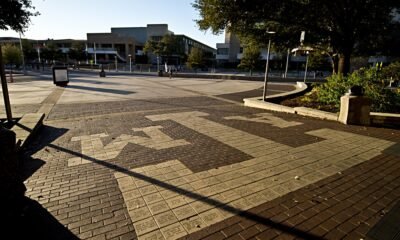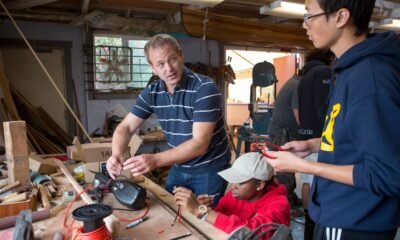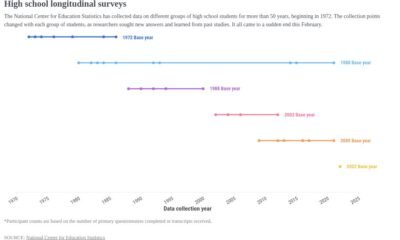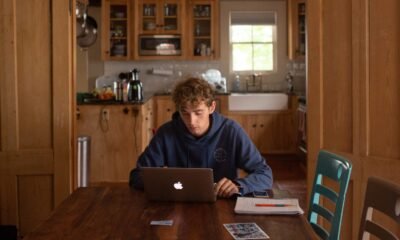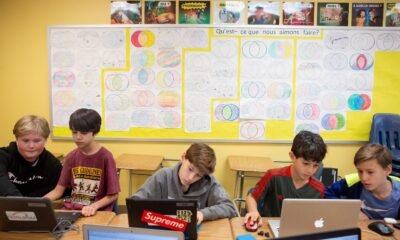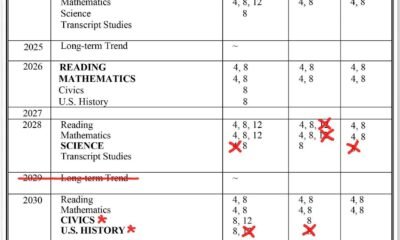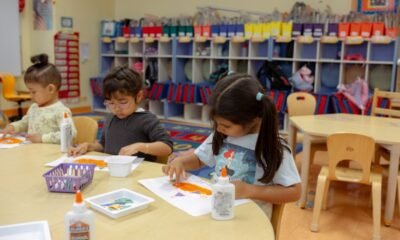Education
A gender gap in STEM widened during the pandemic. Schools are trying to make up lost ground

IRVING, Texas — Crowded around a workshop table, four girls at de Zavala Middle School puzzled over a Lego machine they had built. As they flashed a purple card in front of a light sensor, nothing happened.
The teacher at the Dallas-area school had emphasized that in the building process, there are no such thing as mistakes. Only iterations. So the girls dug back into the box of blocks and pulled out an orange card. They held it over the sensor and the machine kicked into motion.
“Oh! Oh, it reacts differently to different colors,” said sixth grader Sofia Cruz.
In de Zavala’s first year as a choice school focused on science, technology, engineering and math, the school recruited a sixth grade class that’s half girls. School leaders are hoping the girls will stick with STEM fields. In de Zavala’s higher grades — whose students joined before it was a STEM school — some elective STEM classes have just one girl enrolled.
Efforts to close the gap between boys and girls in STEM classes are picking up after losing steam nationwide during the chaos of the Covid pandemic. Schools have extensive work ahead to make up for the ground girls lost, in both interest and performance.
In the years leading up to the pandemic, the gender gap nearly closed. But within a few years, girls lost all the ground they had gained in math test scores over the previous decade, according to an Associated Press analysis. While boys’ scores also suffered during Covid, they have recovered faster than girls, widening the gender gap.
As learning went online, special programs to engage girls lapsed — and schools were slow to restart them. Zoom school also emphasized rote learning, a technique based on repetition that some experts believe may favor boys, instead of teaching students to solve problems in different ways, which may benefit girls.
Old practices and biases likely reemerged during the pandemic, said Michelle Stie, a vice president at the National Math and Science Initiative.
“Let’s just call it what it is,” Stie said. “When society is disrupted, you fall back into bad patterns.”
Related: A lot goes on in classrooms from kindergarten to high school. Keep up with our free weekly newsletter on K-12 education.
In most school districts in the 2008-09 school year, boys had higher average math scores on standardized tests than girls, according to AP’s analysis, which looked at scores across 15 years in over 5,000 school districts. It was based on average test scores for third through eighth graders in 33 states, compiled by the Educational Opportunity Project at Stanford University.
A decade later, girls had not only caught up, they were ahead: Slightly more than half of districts had higher math averages for girls.
Within a few years of the pandemic, the parity disappeared. In 2023-24, boys on average outscored girls in math in nearly 9 out of 10 districts.
A separate study by NWEA, an education research company, found gaps between boys and girls in science and math on national assessments went from being practically non-existent in 2019 to favoring boys around 2022.
Studies have indicated girls reported higher levels of anxiety and depression during the pandemic, plus more caretaking burdens than boys, but the dip in academic performance did not appear outside STEM. Girls outperformed boys in reading in nearly every district nationwide before the pandemic and continued to do so afterward.
“It wasn’t something like Covid happened and girls just fell apart,” said Megan Kuhfeld, one of the authors of the NWEA study.
Related: These districts are bucking the national math slump
In the years leading up to the pandemic, teaching practices shifted to deemphasize speed, competition and rote memorization. Through new curriculum standards, schools moved toward research-backed methods that emphasized how to think flexibly to solve problems and how to tackle numeric problems conceptually.
Educators also promoted participation in STEM subjects and programs that boosted girls’ confidence, including extracurriculars that emphasized hands-on learning and connected abstract concepts to real-life applications.
When STEM courses had large male enrollment, Superintendent Kenny Rodrequez noticed girls losing interest as boys dominated classroom discussions at his schools in Grandview C-4 District outside Kansas City. Girls were significantly more engaged after the district moved some of its introductory hands-on STEM curriculum to the lower grade levels and balanced classes by gender, he said.
When schools closed for the pandemic, the district had to focus on making remote learning work. When in-person classes resumed, some of the teachers had left, and new ones had to be trained in the curriculum, Rodrequez said.
“Whenever there’s crisis, we go back to what we knew,” Rodrequez said.
Related: One state tried algebra for all eighth graders. It hasn’t gone well
Despite shifts in societal perceptions, a bias against girls persists in science and math subjects, according to teachers, administrators and advocates. It becomes a message girls can internalize about their own abilities, they say, even at a very young age.
In his third grade classroom in Washington, D.C., teacher Raphael Bonhomme starts the year with an exercise where students break down what makes up their identity. Rarely do the girls describe themselves as good at math. Already, some say they are “not a math person.”
“I’m like, you’re 8 years old,” he said. “What are you talking about, ‘I’m not a math person?’”
Girls also may have been more sensitive to changes in instructional methods spurred by the pandemic, said Janine Remillard, a math education professor at the University of Pennsylvania. Research has found girls tend to prefer learning things that are connected to real-life examples, while boys generally do better in a competitive environment.
“What teachers told me during Covid is the first thing to go were all of these sense-making processes,” she said.
Related: OPINION: Everyone can be a math person but first we have to make math instruction more inclusive
At de Zavala Middle School in Irving, the STEM program is part of a push that aims to build curiosity, resilience and problem-solving across subjects.
Coming out of the pandemic, Irving schools had to make a renewed investment in training for teachers, said Erin O’Connor, a STEM and innovation specialist there.
The district last year also piloted a new science curriculum from Lego Education. The lesson involving the machine at de Zavala, for example, had students learn about kinetic energy. Fifth graders learned about genetics by building dinosaurs and their offspring with Lego blocks, identifying shared traits.
“It is just rebuilding the culture of, we want to build critical thinkers and problem solvers,” O’Connor said.
Teacher Tenisha Willis recently led second graders at Irving’s Townley Elementary School through building a machine that would push blocks into a container. She knelt next to three girls who were struggling.
They tried to add a plank to the wheeled body of the machine, but the blocks didn’t move enough. One girl grew frustrated, but Willis was patient. She asked what else they could try, whether they could flip some parts around. The girls ran the machine again. This time, it worked.
“Sometimes we can’t give up,” Willis said. “Sometimes we already have a solution. We just have to adjust it a little bit.”
Lurye reported from Philadelphia. Todd Feathers contributed reporting from New York.
The Associated Press’ education coverage receives financial support from multiple private foundations. AP is solely responsible for all content. Find AP’s standards for working with philanthropies, a list of supporters and funded coverage areas at AP.org.
Education
Online misinformation putting women off contraceptive pill, study finds | Health
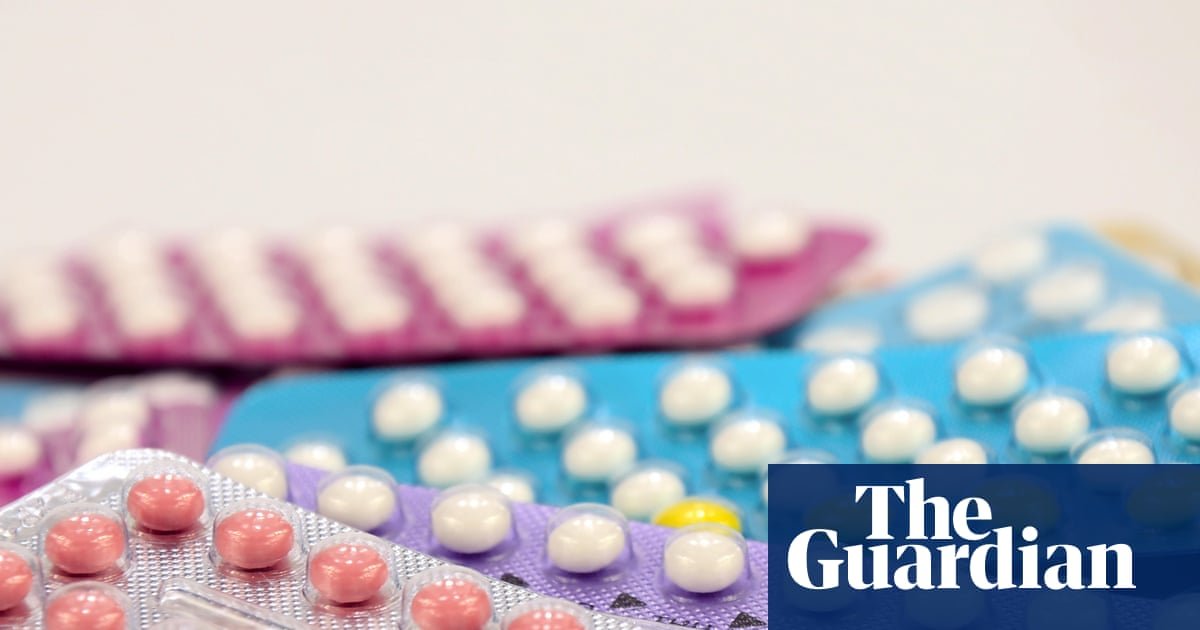
Social media misinformation about the contraceptive pill is encouraging women to view it so negatively that many give it up, a study has found.
Researchers have identified myths spread on TikTok and other social media platforms as a key driver of users suffering side-effects that are real but psychological in origin. It is called the “nocebo effect”, the opposite of the better-known placebo effect.
Experiencing it is closely linked to anxiety, depression and fatigue, with experts saying people become “wary of anything that they believe might make [the conditions] worse”. This, in turn, spurs on the effect.
It has been seen with other medicines, but the study, by psychologists at Sheffield University, is the first to link the syndrome with use of the pill, which has fallen sharply.
The pill remains the most popular form of contraception in England, but the proportion of women who access NHS sexual health services and use the pill as their form of birth control fell from 39% in 2020-21 to 28% in 2023-24.
Sexual health experts believe the decline in uptake, and the fact that two-thirds of women who use it stop doing so within two years, is a major reason why the number of abortions in England and Wales has risen sharply in recent years and hit an all-time high of 251,377 in 2022 – 17% up on the previous year.
NHS bosses are worried about the role of influencers on TikTok and YouTube, who have posted content that warns women against using the pill and advocate using “natural” birth control instead.
For example, one has claimed that the pill “robs us of our health” because of “common” side-effects including an alleged heightened risk of thyroid problems, blood clots and strokes.
Dr Rebecca Webster and Lorna Reid, the co-authors of the study, found that the “nocebo effect” involved four psychological factors that were associated with women having a negative experience of the pill. They were:
-
An expectation at the outset that the pill will be harmful.
-
Low confidence in how medicines are developed.
-
A belief that medicines are overused and harmful.
-
A belief that they are sensitive to medicines.
“The evidence suggests that many of the commonly reported side-effects of hormonal contraception are a result of psychological, or nocebo, response to the act of taking oral contraceptives,” Webster said.
“Despite these being psychological in origin, it’s important to understand that these are very real experiences for women, often affecting their decision to continue taking the pill.”
The authors wrote: “Medicine-related beliefs were associated with increased experience of oral contraceptive side-effects, demonstrating the potential role that nocebo-related factors may have in impacting oral contraceptive side-effect experience.”
Their findings were based on a study of 275 women aged 18-45 who had used the pill over the previous 18 months. Almost all – 266 (97%) – experienced at least one side-effect while doing so.
They found that women’s expectations that they would have a negative experience of the pill from the outset often proved self-fulfilling. But negative messaging about the pill in the media and a belief that medicines are harmful or over-used raised the risk of them reacting badly to it.
“I think since Covid there’s the anti-facts, anti-big pharma rhetoric coming out on social media. I think that’s had an effect”, said Dr Janet Barter, the president of the College of Sexual and Reproductive Healthcare, which represents sexual health specialists.
“But I think also we know that a lot of young people are suffering with their mental health, with either depression or particularly anxiety. So they’re likely to be very wary of anything that they believe might make that worse.”
Brook, a large sexual health services provider, also blamed online misinformation for helping to create the “nocebo effect” the researchers identified.
“Young people in particular are influenced by what they see and hear about contraception. People in our clinics are increasingly expressing concern about hormonal contraception due to things they have heard on social media”, said Laua Domegan, Brook’s head of nursing.
“Common myths include that the pill will make you gain weight, will impact your long-term fertility or even affect the kinds of people you are attracted to.”
Misinformation about the pill was gaining traction because health professionals did not give women enough information about contraception and also because schools did not include enough about it in sex and relationships classes, she added. More “honest conversations” were needed, she said.
However, Webster and Reid argue in their paper, published in Perspectives on Sexual and Reproductive Health, that because many women’s bad reactions to the pill are psychological in origin, that “psychological interventions” – such as challenging negative beliefs about medication – could be used to cut side-effects and keep them using the pill.
Education
AI tools to sweep through UCLA STEM departments, expanding education through AIMS

AI learning tools will be introduced to undergraduate physics and math courses this fall.
The Artificial Intelligence and Math Skills program, a two-year project aiming to decrease learning disparities in introductory STEM courses, will be implemented across physical and life science courses to improve student learning experiences, according to the UCLA Center for Education Innovation & Learning in the Sciences website. The program will use supplemental math materials and AI hinting tools to support students who need more support with mathematical skills, according to the website.
The initiative stems from a joint study conducted by UCLA and UCSD faculty members, which found that incentivized supplemental math assignments are associated with improved exam performance.
Alexander Kusenko, a professor of physics and astronomy at UCLA who serves as the primary investigator for the AIMS project, said levels of performance in calculus and physics courses vary for students from different socioeconomic backgrounds. The results of the study showed that supplemental learning methods and Kudu – an AI learning platform that provides restricted AI-generated hints to students needing support – were associated with higher exam scores for students, he added.
This learning model can be applied in many undergraduate STEM courses, said Shanna Shaked, senior associate director of CEILS who serves as a collaborator on the AIMS initiative. She added that she believes one of the most exciting aspects of this model is how it incentivizes supplemental math activities, as the students who score lowest on exams will earn the most points for completing the supplemental resources.
“That makes me very excited, because we have discovered something useful. And it’s working for all the students, but particularly for the students who need most help,” Kusenko said.
Shaked said the AIMS initiative is funded by the Teaching and Learning Center Tier 4 Grant – which supports larger-scale educational innovations that promote student exploration, creativity, engagement, discovery and success, according to the TLC website. The program was awarded a Track 2 Implementation Grant, which can provide up to $100,000 to teams of faculty and students seeking to tackle student needs and challenges through pedagogical transformation, the website said.
K. Supriya, associate director of CEILS who co-authored the study and serves on the AIMS program, said federal funding cuts affected research for this initiative, as researchers submitted an NSF proposal a few days before UCLA’s funding was paused, and have yet to receive feedback.
[Related: Research grant suspension impacts applied mathematics program, collaboration]
Shaked added that the TLC grant was critical to the implementation of the AIMS project because it is not associated with national funding allocations, allowing research to continue.
“Thanks to that grant, we’re able to keep doing some of the work,” Shaked said. “Not nearly in as much depth or with as much evaluation and research as we would like, but certainly able to continue broadening the use of these promising interventions.”
The TLC funds will be used to support graduate students who help develop materials for the program, as well as the instructors and investigators who implement the program, Shaked said. She added that the grant allows researchers to continue working on the AIMS project, but many participating faculty members are also being impacted by the research funding freeze, which makes adequate compensation for their work and time more challenging.
As the program grows, Supriya said the project will expand its implementation of AI learning tools to introductory chemistry courses, such as general chemistry, with the hope of reaching life sciences courses.
If evidence shows that incentivized supplemental assignments are effective in different contexts and settings, these tools could be useful for instructors at all levels and for all kinds of courses, Supriya added.
As AI becomes increasingly integrated into higher educational institutions, Supriya said researchers should explore how initiatives like AIMS can maintain or increase student learning by offering tailored support.
“It’s a helpful tool,” Supriya said. “I only see the use of such things growing over the next five years.”
Contributing reports by Shaun Thomas, science and health editor.
Education
What I wish I knew before going to university

 BBC
BBCOver the next couple of weeks, hundreds of thousands of new students will descend on universities around the country.
For many, this will mark the start of a brand new adventure – though one often filled with a lot of worry.
To help with nerves, BBC News asked for tips from 2024’s first-years, who’ve already sussed out being freshers.
From balancing studies and social life, to looking after your mental health and the importance of doing the washing up, this is what the class of 2024 have to say to the new kids on the block.
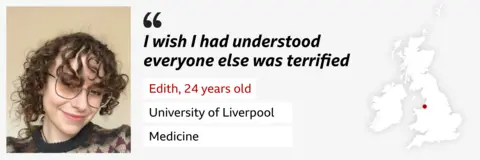
Edith Adam says she was “terrified” when she moved to Liverpool last year to study medicine.
What she hadn’t realised at the time was that other freshers were just as scared as she was.
“I was absolutely terrified about not being able to make friends or that people wouldn’t like me,” says Edith, who’s now going into her second year.
“I wish I had understood everyone else was terrified, and that they appreciate it when you go up to them and say hi.”
 Edith Adam
Edith AdamHaving never been to Liverpool before – a city with a party reputation – Edith worried she might not fit in.
“I was really scared of being ostracised for not wanting to go clubbing every night and not being a drinker,” she says.
But Edith was still able to find her people.
“No one actually cares. There are plenty of things you can do that don’t revolve around late nights. Just find what works for you.”
 Edith Adam
Edith AdamThe 24-year-old, from Huddersfield, says her advice would be not to put too much importance on the infamous freshers’ week.
“I think everyone goes in with the expectation that it’s this amazing, wild week, where you meet your best friends for life and have your best time at uni,” she says.
And her top tip for staying friends with your flatmates?
“If it takes less than two minutes, just do it,” Edith says. “It’s so easy for everything to pile up, and then you don’t wash your plates for five days, and all of a sudden everything is dirty and you have no cutlery – and your flatmates hate you.”

But what if you can’t make freshers week?
This is the situation Konstantin Schmidt faced last year, after issues with his visa delayed his start at Greenwich University by five weeks.
Although people told him the freshers parties he’d missed out on were “fun”, the mechanical engineering student says he still managed to settle in well by joining up to student clubs.
“Societies are the best way to find people who share the same passion,” Konstantin says.
 Konstantin Schmidt
Konstantin SchmidtJoining both a volleyball society and the Formula One society, he says he had positive interactions right from the off.
“The second I joined the room the members saw I was new and instantly included me,” Konstantin says. “I also met new people through volleyball who were on my course who quickly became my friends.”
 Konstantin Schmidt
Konstantin SchmidtThe 21-year-old bonded with his flatmates by exploring each other’s culture through food and music.
In his first weeks, Konstantin, who’s from Bavaria in Germany, made Spätzle – a pasta dish topped with grilled cheese for a dinner party with his flatmates.
“Everyone really liked” his food, he says – but he admits the best dish was a Filipino one made by his flatmate, Kai.
“It helped us understand everyone’s culture even better,” Konstantin says.

While many people starting university will be living away for the first time, some students still live at home.
Commuting more than an hour each way between Glasgow and Edinburgh, Rebecca can relate.
“If they forget something, my friends can just nip back to their accommodation, whereas I can’t, ” she says. “But it’s not bad, I like commuting in.”
Going into her second year of a business management course, Rebecca is now much more organised and comfortable with the journey, after experiencing some hiccups in her first year.
 Handout
HandoutIn some cases, cancelled trains meant she had to pay for a taxi all the way to Edinburgh.
“In second year I will definitely be checking my trains,” Rebecca says.
Her advice for freshers is simple: “Make sure your bag is fully packed with everything you might need – and plan your commute.”
Rebecca’s university experience has been different from many others as she was only 16 when she started her course.
“I thought everyone was going to be older and not want to speak to me,” she says. “But it wasn’t like that at all. The age gap doesn’t really matter.”
 Handout
HandoutNow 17, Rebecca is still waiting to experience a full freshers’ week, but says she was still able to attend under-18 events.
Her advice for those in a similar position?
“Don’t be afraid to ask for help,” she says. “I felt like I couldn’t ask for help because people would think I didn’t deserve to be there because I’m younger.
“They don’t care that you’re 16 or 17. Just ask for help.”
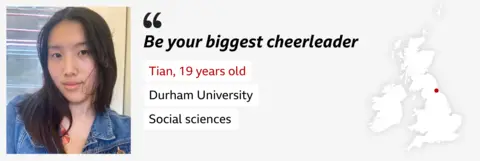
As the first in her family to go to university, Tian Liu didn’t know what to expect before she started her combined honours degree in social sciences.
“I did so much research, but I still felt so unprepared,” Tian says. “University is definitely a roller coaster. There was a point I wanted to drop out, but now I can definitely see the fruits of my labour.”
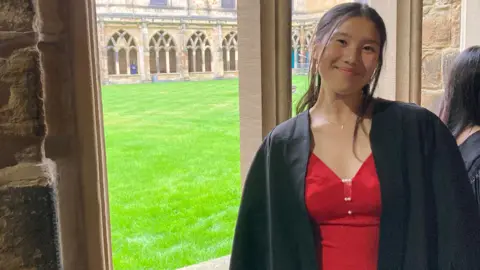 Tian Liu
Tian LiuNow going into her second year, the 19-year-old has found a better balance and would advise incoming students to look after their mental health.
“With tuition fees rising there is such a pressure to make the most out of it, but you can burn out,” Tian says. “University is as much as you make of it, but give yourself grace.
“Have close friends who can act as support and accountability if you are doing too much, and use pastoral teams that the university offers,” she adds.
“There is no need to rush, it’s all a constant learning curve.”
 Tian Liu
Tian LiuOne year on from moving to Durham from Leeds, Tian is in New York completing an internship she got through her university – something she “could never have imagined” last year.
Her advice for incoming students?
“Don’t disqualify yourself from anything. Be your biggest cheerleader. And take so many photos.”
-

 Business2 weeks ago
Business2 weeks agoThe Guardian view on Trump and the Fed: independence is no substitute for accountability | Editorial
-
Tools & Platforms1 month ago
Building Trust in Military AI Starts with Opening the Black Box – War on the Rocks
-

 Ethics & Policy2 months ago
Ethics & Policy2 months agoSDAIA Supports Saudi Arabia’s Leadership in Shaping Global AI Ethics, Policy, and Research – وكالة الأنباء السعودية
-

 Events & Conferences4 months ago
Events & Conferences4 months agoJourney to 1000 models: Scaling Instagram’s recommendation system
-

 Jobs & Careers2 months ago
Jobs & Careers2 months agoMumbai-based Perplexity Alternative Has 60k+ Users Without Funding
-

 Podcasts & Talks2 months ago
Podcasts & Talks2 months agoHappy 4th of July! 🎆 Made with Veo 3 in Gemini
-

 Education2 months ago
Education2 months agoVEX Robotics launches AI-powered classroom robotics system
-

 Education2 months ago
Education2 months agoMacron says UK and France have duty to tackle illegal migration ‘with humanity, solidarity and firmness’ – UK politics live | Politics
-

 Podcasts & Talks2 months ago
Podcasts & Talks2 months agoOpenAI 🤝 @teamganassi
-

 Funding & Business2 months ago
Funding & Business2 months agoKayak and Expedia race to build AI travel agents that turn social posts into itineraries


